|
The December 1950 issue of
Radio & Television News magazine ran a series of articles on Navy communications.
This was a mere four years after the end of World War II and right at the beginning
days of the Korean War. Communist and fascist regimes never give the world a moment's
rest (some - not me - think just being nice to them will cause them to be nice in
return). Discussed here are issues still relevant to modern outfitting of naval
assets with new or updated communications equipment. Unlike land-based systems,
naval environments impose increased requirements for ruggedness due to harsh vibration,
impact, and corrosion issues. Weight added above the waterline needs to be offset
with weight below the water line to preserve stability. Reliability and personnel
training also need to be increased because being at sea means access to replacement
parts, operators, and service technicians are harder to accommodate. The military
people (officer and enlisted) who do the work do so out of dedication and a sense
of honor and country. Otherwise, why would they accept pay and living conditions
far inferior to the average New York City garbage collector?
Thanks to Terry W. for providing this article.
Technical Aspects of Naval Communications
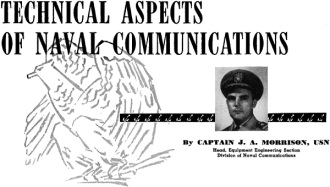
Head, Equipment Engineering Section, Division of Naval Communications
Graduated U. S. Naval Academy In 1926, completed post-graduate course in electronic
engineering in 1935. Officer-in-Charge of U. S. Navy Radio Material School at Anacostia,
D.C. from 1938-49. During war served as Communication Officer attached to British
Combined Operations Staff, attached to Allied Forces' Headquarters (North African
Campaign), served on USS Yorktown, and become Communication Officer, U. S. Naval
Forces (Europe). Except for two years in San Juan, Puerto Rico, he has headed the
Equipment Engineering Section of the Division of Naval Communications since 1945.
By Captain J. A. Morrison, USN
A "behind-the-scenes" review of the problems involved in coordinating the U.
S. Navy's vast research, procurement, and installation programs.
The Naval Communication Service is provided for by the Navy Communication System
(shore stations) and shipboard radio facilities. The shipboard facilities provide
communication channels between ships, fleet, and task force commanders. Ship-shore
and air-ground circuits are part of the entire service. The primary, major, and
minor relay stations of the Naval Communication System employing wire and radio
systems both automatic and manual, handle the Navy's point-to-point traffic and
fleet broadcasts. To maintain this service, both shore station and ship require
the very latest and most modern type of communication equipment.
To accomplish progressive improvement in fleet communications, the Office of
Chief of Naval Operations' staff includes trained electronic officers who are thoroughly
familiar with ship and shore communication systems. These officers hold membership
in various Joint and Combined Electronic groups, Electronic Committees of the National
Research and Development Board, the Munitions Board, the International Telegraph
Union, and many other civil and military electronic organizations. Careful attention
is paid to system-wise engineering to insure that communications can be maintained
with the U. S. Army and the Air Force units, certain foreign military and commercial
systems, as well as with domestic U. S. commercial systems.
Technical reports from the civil and military research laboratories are carefully
reviewed in order that new methods or techniques that have military application
may be considered and adopted, if improvement to naval communications is indicated.
As technological advances in design of new weapons are made, either by unfriendly
nations or by the United States, tactics or counter tactics are developed in our
operational planning sections to take advantage of, or overcome them.
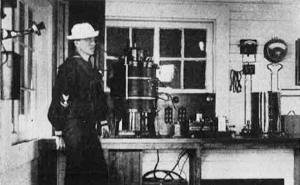
Interior of an operating building at U. S. Naval Radio Station,
Mare Island, California in 1904. Note "dated" equipment.
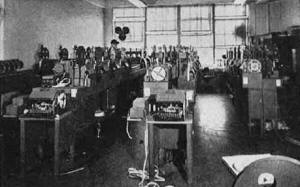
Monitoring equipment, installed at Navy Radio in Washington,
D. C., makes a record of all transmissions over the system.
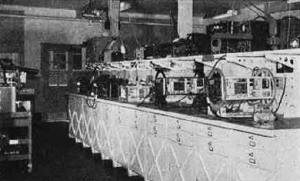
A Navy workshop setup for testing and repairing aviation communication
and other electronic equipment.
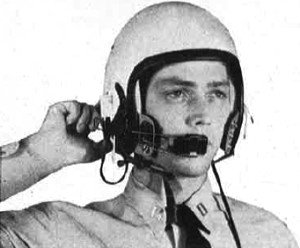
This protective helmet for pilots is literally "wired for sound."
It contains a built-in headset and an adjustable microphone unit.
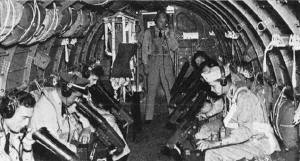
Navy communication and radar training on board an R4D (Navy's
version of the AAF's C-47 Dakota) electronics flying classroom.
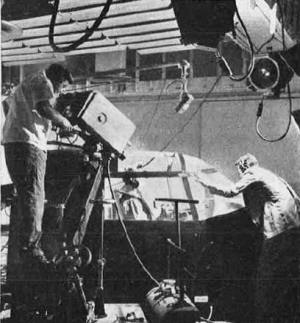
A television camera peers into the cockpit of a mock-up Navy
bomber as the "pilot" and "co-pilot" demonstrate a simplified control system. By
means of microwave or coaxial cable relays the demonstration can be witnessed by
personnel at remote naval stations or units of the fleet. The Navy is experimenting
with mass training by television at Sands Point, Long Island.
This ever-changing struggle presents naval communication equipment and system
engineers with the task of not only satisfying current requirements, but at the
same time solving the problem of arranging research, development, procurement, and
installation programs to insure that equipment and systems, sometimes of comparative
radically changed characteristics, will be available should war come suddenly. As
far as the Navy is concerned, when it is realized that from writing the specifications
to the completion of the installation in all ships of the fleet of just one piece
of communication equipment, may take as long as four years, even under wartime production
schedules, the job of keeping fleet communication systems fitted with equipment
of advanced design can be appreciated.
To insure that the best equipment available is purchased, a considerably complicated
process must be followed. A government purchase involving the taxpayers' money must
be justified as thoroughly as practicable, and all manufacturers must, under the
law, be given opportunity to obtain the contract. The primary requisite for a justification
is known as an operational requirement.
Operational requirements originate in the Office of the Chief of Naval Operations,
and are based upon fleet doctrine, fleet tactics, and ship developments. Since shore
stations exist fundamentally to support the fleet, an operational requirement for
shore communication equipment generally stems from a fleet requirement.
These operational requirements are studied in the Naval Communication Division
of the Navy Department, and from these studies are determined the allowances of
equipments per ship and shore station that will fulfill them. The equipments required
are listed by frequency range, distance coverage necessary, and the type of emission
desired. In the case of ships, the requirements are listed in a Tentative Type Allowance,
one being prepared for each type of Navy ship. The Bureau of Ships proceeds to fill
this allowance with equipment available. If the equipment available will not meet
the specified requirement, or cannot be economically modified, then new equipment
must be developed and procured.
The first step in the development of new equipment is to write a set of military
characteristics. These characteristics are written in broad terms to cover fully
the operational requirement. After the preparation in the Office of the Chief of
Naval Operations, the characteristics are submitted to the Joint Communications
Electronics Committee of the Joint Chiefs of Staff, which is composed of representatives
of the Army, Navy, and Air Force. The characteristics are studied for possible joint
interest, and yield information as to whether equipment already exists, or is planned,
that will fill the requirements. Technical and operational sections of the three
Services study the characteristics and determine whether or not there is a joint
interest in the proposed development.
After approval of the Joint Committee, the characteristics are forwarded to the
Bureau of Ships. As the next step, the Bureau of Ships, using the military characteristics
as a guide, writes a set of technical specifications. Here, in the interest of economy,
before a contract is placed, coordination to prevent undesirable duplication of
effort is achieved. A proposed Research and Development project is forwarded to
the Electronic Committee of the Research and Development Board for consideration.
This committee comprises representatives of the three Services, as well as civilian
members eminent in the electronics field. After similar development projects are
scrutinized, and if no undesirable duplication is apparent, the Research and Development
Board approves the project.
The specifications are then submitted to manufacturers for contract bids by the
Bureau of Ships, and after the bid has been awarded, the research and development
stage follows, under the close supervision of Navy engineers. The acceptance tests
follow the development, and finally the service evaluation tests are conducted aboard
a station or ship before the equipment is approved and purchased. In the case of
shipboard equipment, the service tests are performed by the Commander, Operational
Development Force who has available to him highly qualified technical personnel
and various types of ships and aircraft for which the equipment is intended. The
service evaluation tests consist of actually using the equipment under conditions
which duplicate its ultimate employment, with naval personnel operating and maintaining
it to make absolutely sure that it will fulfill the operational requirement, and
meet the rigid physical standards imposed by the specifications. The foregoing procedure,
while it is admittedly slow, assists greatly in providing for the U. S. Navy reliable,
rugged, and compact communication equipment, as economically as possible, and with
the least impact possible on research and manufacturing agencies. The communication
equipment for the U. S. Navy falls generally into two groupings: (1) shore, and
(2) ship.
Shore Station Equipment
Shore station communication equipment must possess all of the features of reliability,
long life, stability, and low maintenance, the same as shipboard equipment. Certain
features, such as ruggedness, small size, and weight are not so important. Shore
stations exist to provide long distance communications in large volumes; hence,
the equipment is large and powerful, and no limits are placed upon the size of the
radiating system required for the job. Transmitters in the order of 500 kw. to 1000
kw. are used, together with huge amounts of terminal equipment for single side-band
and electronic multiplexing. Very low frequency transmitters give the fleet world
wide broadcast coverage. Transmitting, receiving, and control stations are separated
by several miles, and thus must be linked to-gether with landline or v.h.f. control
links. Recent developments indicate a trend toward PTM (pulse time modulation) for
replacement of the very-high frequency links. PTM offers more flexibility and more
channels for the Navy's operational requirements.
Shipboard Equipment
Shipboard installations are restricted in size and weight, depending upon the
type of vessel involved. Practically, this means that on some ships when a piece
of equipment of any sort is placed in a ship the weight added must be compensated
for; either by removing an equal weight, or if the equipment is installed above
the water line, an equal weight must be inserted near the keel to preserve the stability.
Similarly, space being at a premium in war vessels, consideration must be given
the size of the equipment in order that other essential material may also be accommodated.
This explains why those portions of Naval military characteristics and technical
specifications which have to do with size and weight are most rigid and severe.
In addition to the size and weight factors, because of the extreme ranges of
temperature, exposure to salt water spray, deterioration due to humidity and the
wear and tear of a ship at sea to which the equipment is subjected, the problem
of providing adequate equipment to meet the numerous operational needs is not an
easy one.
The limited space above decks, for which requirements for guns, radars, signal
searchlights, and other special electronic devices compete with increased numbers
of communication antennas to meet expanding circuit requirements, all of which specify
omni-directional coverage, has placed increasing demands upon Navy Engineers for
efficient antenna systems. Such research is a continuing project within the Navy,
and of late years, considerable emphasis has been accorded it. Recently developed
common antenna working systems show promise of producing some gratifying results.
In general, shipboard equipment is growing smaller, more compact, more stable,
lighter, automatic, and rugged, It is hoped that miniaturization of components will
reduce further their size and weight. On the other hand, the effort to meet the
ever growing operational requirements and at the same time reduce the size and weight
has introduced, in some cases, more complicated and complex equipment. This is a
serious problem in view of the present shortage of Navy Electronic Technician Mates.
Therefore, specifications are beginning. to emphasize packaging of components for
quick replacement to enable disabled equipment to remain on the air. The repair
of the particular circuit can be accomplished at a later time. As a result of a
standardization program, it is planned to replace the various models of transmitters
and receivers installed aboard our ships with an all-purpose series of transmitters
and receivers. This modernization will assist to some extent in reducing the maintenance
and spare parts provisions and stowage problems. The latter is one which has long
plagued the logisticians. With numerous different types of equipments installed
in ships, the provision and stowage of sufficient spare parts for self-sufficient
operations presents many space and weight compensation problems. By standardization
of equipments, components, and revising stowage methods aboard ships, a reduction
of perhaps 50% in cubeage and weight per ship is anticipated.
In the development of any new equipment, the Naval Communication Service is guided
largely by programs of systems-wise engineering. At the present time, there are
three such programs that might be listed, They are : (1) ultra-high frequency conversion,
(2) teletype, and (3) radiophoto-facsimile,
The ultra-high frequency band was chosen because of the possibility of obtaining
more channels to provide for our tactical requirements. It is an all-purpose band
and will be used by all three military services on air-to-air, air-to-ground, and
ground-to-ground circuits. Considerable difficulty has been experienced in developing
equipment in this band, mainly because of frequency stability considerations; however,
the demanding specifications have brought about successful research on new circuits,
new techniques, and new automatic control devices and considerable progress has
been made. For instance, the perfection of techniques to realize narrower channel
bandwidths has produced nearly double the communication channels than was hoped
for originally, Since this equipment must be installed aboard all types of ships
and craft, as well as planes, attainment of small size and weight are being emphasized.
This u.h.f. system will ultimately replace the very-high frequency system now in
use.
Increasing traffic loads and high speed targets have resulted in more and more
emphasis being placed upon the use of automatic equipment. The manual c.w. circuit
is considered the "horse and buggy" type of communications and, like the horse and
buggy, is highly reliable, but very slow. The teletypewriter program is an effort
to shift naval communications from the manual method to the machine method, and
has been successfully accomplished in the Navy Communication System (shore stations).
A partial shift has been made in the fleet in that ship-shore teleprinter circuits
exist for the use of those ships equipped with radio teletype equipment, It is hoped
that the fleet broadcasts may soon be made by this method. Radio teletype equipment
aboard ship is up against the same old problem of weight and space. Hence, new equipment
is being developed that is smaller, lighter, and more compact - a distinct advance.
In line with the trend toward automatics, the radiophoto-facsimile program is
the latest additional service to be provided by the Naval Communication Service.
The operational requirement for the transmission of maps, charts, and official documents
has spurred on the development of radiophoto-facsimile equipment. Future developments
indicate strongly that this equipment will become an integral part of shore station
and shipboard installations.
Considerable thought has been given to multiplexing equipment for increasing
the capacity of the existing communication circuits. The limited frequency spectrum
available has encouraged this development.
Looking into the future, more and more attention will be paid to data transmission
systems. In this atomic energy age, faster and faster methods of communications
will be necessary to support military operation. Furthermore, with the U. S. Armed
Services working as a team with allied forces, coordinated communications are a
must. All equipment developments must continue to be done along joint specifications
so that the Services can work easily into each others' systems. Military characteristics
will insist that equipment be developed for joint use, that it be reliable, small
and compact as possible with miniaturized components, stable, easily serviced, rugged,
and easy to operate and that certain features be automatic. In this manner the U.
S. Navy will continue to obtain the best equipment for war purposes that money can
buy.
Posted December 2, 2021
(updated from original post on 5/28/2013
|
















